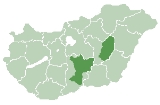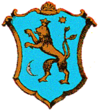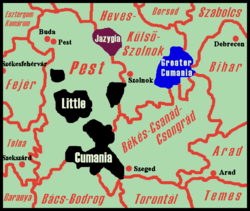
Kunság
Encyclopedia


Hungary
Hungary , officially the Republic of Hungary , is a landlocked country in Central Europe. It is situated in the Carpathian Basin and is bordered by Slovakia to the north, Ukraine and Romania to the east, Serbia and Croatia to the south, Slovenia to the southwest and Austria to the west. The...
situated in the current Bács-Kiskun
Bács-Kiskun
Bács-Kiskun is a county located in southern Hungary. It was created as a result of World War II, merging the pre war Bács-Bodrog and the southern parts of Pest-Pilis-Solt-Kiskun counties. With an area of 8,445 km2, Bács-Kiskun is the largest county in the country. The terrain is mostly flat...
and Jász-Nagykun-Szolnok
Jász-Nagykun-Szolnok
This article is about the modern county, for the historical one see Jász-Nagykun-Szolnok .Jász-Nagykun-Szolnok is the name of an administrative county in Hungary. It lies in central Hungary and shares borders with the Hungarian counties Pest, Heves, Borsod-Abaúj-Zemplén, Hajdú-Bihar, Békés,...
counties. Like other historical European regions called Cumania
Cumania
Cumania is a name formerly used to designate several distinct lands in Eastern Europe inhabited by and under the military dominance of the Cumans, a nomadic tribe who, with the Kipchaks, created a confederation. The Cumans were also known as the Polovtsians, or Folban...
, it is named for the Cumans
Cumans
The Cumans were Turkic nomadic people comprising the western branch of the Cuman-Kipchak confederation. After Mongol invasion , they decided to seek asylum in Hungary, and subsequently to Bulgaria...
, a nomad
Nomad
Nomadic people , commonly known as itinerants in modern-day contexts, are communities of people who move from one place to another, rather than settling permanently in one location. There are an estimated 30-40 million nomads in the world. Many cultures have traditionally been nomadic, but...
ic tribe of pagan Kipchaks
Kipchaks
Kipchaks were a Turkic tribal confederation...
that settled the area. It is divided into Greater Cumania
Greater Cumania
Nagykunság is a historical and geographical region in Hungary situated in the current Jász-Nagykun-Szolnok county between Szolnok and Debrecen. Like other historical European regions called Cumania, it is named for the Cumans, a nomadic tribe of pagan Kipchaks that settled the area.-See...
and Little Cumania
Little Cumania
Kiskunság is a historical and geographical region in Hungary situated in the current between Kalocsa and Szeged. Like other historical European regions called Cumania, it is named for the Cumans , a historically very significant nomadic tribe -See also:...
.
Ethnic affiliations and genetic origins
In a study by Bogacsi-Szabo, Erika. et. al. (2005) of the mtDNA (Mitochondrial DNA) of the Cuman nomad population that migrated into the Carpathian basin during the 13th century, six haplogroups were revealed. "One of these haplogroups belongs to the M lineage (haplogroup DHaplogroup D (mtDNA)
In human mitochondrial genetics, Haplogroup D is a human mitochondrial DNA haplogroup.-Origin:Haplogroup D is believed to have arisen in Asia some 48,000 years before present. It is a descendant haplogroup of haplogroup M.-Distribution:...
) and is characteristic of Eastern Asia, but this is the second most frequent haplogroup in southern Siberia too. All the other haplogroups (H, V, U, U3, and JT) are West Eurasian, belonging to the N macrohaplogroup. Out of the eleven remains, four samples belonged to haplogroup H
Haplogroup H (mtDNA)
In human mitochondrial genetics, Haplogroup H is a human mitochondrial DNA haplogroup that likely originated in Southwest Asia 25,000-30,000 YBP.-Origin:...
, two to haplogroup U, two to haplogroup V, and one each to the JT, U3, and D haplogroups. Modern Hungarian samples represent 15 haplogroups. All but one is a West Eurasian haplogroup [the remaining one is East Asian (haplogroup F)], but all belong to the N lineage. Four haplogroups (H, V, U*, JT), present in the ancient samples, can also be found in the modern Hungarians, but only for haplogroups H and V were identical haplotypes found. Haplogroups U3 and D occur exclusively in the ancient group, and 11 haplogroups (HV, U4, U5, K, J, J1a, T, T1, T2, W, and F) occur only in the modern Hungarian population. Haplogroup frequency in the modern Hungarian population is similar to other European populations, although haplogroup F is almost absent in continental Europe; therefore the presence of this haplogroup in the modern Hungarian population can reflect some past contribution."
"The results suggested that the Cumanians, as seen in the excavation at Csengele
Csengele
Csengele is a village in Csongrád county, in the Southern Great Plain region of southern Hungary.-Geography:It covers an area of and has a population of 2043 people ....
, were far from genetic homogeneity. Nevertheless, the grave artifacts are typical of the Cumanian steppe culture; and five of the six skeletons that were complete enough for anthropometric analysis appeared Asian
Asia
Asia is the world's largest and most populous continent, located primarily in the eastern and northern hemispheres. It covers 8.7% of the Earth's total surface area and with approximately 3.879 billion people, it hosts 60% of the world's current human population...
rather than European
Europe
Europe is, by convention, one of the world's seven continents. Comprising the westernmost peninsula of Eurasia, Europe is generally 'divided' from Asia to its east by the watershed divides of the Ural and Caucasus Mountains, the Ural River, the Caspian and Black Seas, and the waterways connecting...
(Horváth 1978, 2001), including two from the mitochondrial haplogroup H
Haplogroup H (mtDNA)
In human mitochondrial genetics, Haplogroup H is a human mitochondrial DNA haplogroup that likely originated in Southwest Asia 25,000-30,000 YBP.-Origin:...
, which is typically European. It is interesting that the only skeleton for which anthropological examination indicated a partly European ancestry was that of the chieftain, whose haplotype is most frequently found in the Balkans."
History

Kingdom of Hungary
The Kingdom of Hungary comprised present-day Hungary, Slovakia and Croatia , Transylvania , Carpatho Ruthenia , Vojvodina , Burgenland , and other smaller territories surrounding present-day Hungary's borders...
, the Cumans inhabited the vast areas of the Pontic-Caspian steppe
Pontic-Caspian steppe
The Pontic-Caspian steppe is the vast steppeland stretching from the north of the Black Sea as far as the east of the Caspian Sea, from western Ukraine across the Southern Federal District and the Volga Federal District of Russia to western Kazakhstan,...
, where they had created a powerful nomadic confederacy (see Cumania
Cumania
Cumania is a name formerly used to designate several distinct lands in Eastern Europe inhabited by and under the military dominance of the Cumans, a nomadic tribe who, with the Kipchaks, created a confederation. The Cumans were also known as the Polovtsians, or Folban...
). In the 13th century, they were attacked and defeated by the Mongol Empire
Mongol Empire
The Mongol Empire , initially named as Greater Mongol State was a great empire during the 13th and 14th centuries...
after which most of them fled to Hungary, the Bulgarian Empire
Second Bulgarian Empire
The Second Bulgarian Empire was a medieval Bulgarian state which existed between 1185 and 1396 . A successor of the First Bulgarian Empire, it reached the peak of its power under Kaloyan and Ivan Asen II before gradually being conquered by the Ottomans in the late 14th-early 15th century...
, and the Byzantine Empire
Byzantine Empire
The Byzantine Empire was the Eastern Roman Empire during the periods of Late Antiquity and the Middle Ages, centred on the capital of Constantinople. Known simply as the Roman Empire or Romania to its inhabitants and neighbours, the Empire was the direct continuation of the Ancient Roman State...
.
The first Cumans arrived in Hungary in 1239 but there was violence between the nomadic Cumans and the settled Hungarians. Hungarians murdered the Cuman leader Kuthen (Kötöny) and the Cumans fled to the Balkans in 1241, pillaging as they went.
Following the Mongol invasion
Mongol invasion of Europe
The resumption of the Mongol invasion of Europe, during which the Mongols attacked medieval Rus' principalities and the powers of Poland and Hungary, was marked by the Mongol invasion of Rus starting in 21 December 1237...
of Hungary in 1246, King Béla IV
Béla IV of Hungary
Béla IV , King of Hungary and of Croatia , duke of Styria 1254–58. One of the most famous kings of Hungary, he distinguished himself through his policy of strengthening of the royal power following the example of his grandfather Bela III, and by the rebuilding Hungary after the catastrophe of the...
, invited 40 to 60 thousand Cumans and smaller group of Jazyges back to Hungary to settle in areas of the Great Hungarian Plain
Great Hungarian Plain
The Great Hungarian Plain is a plain occupying the southern and eastern part of Hungary, some parts of the Eastern Slovak Lowland, southwestern Ukraine, the Transcarpathian Lowland , western Romania , northern Serbia , and eastern Croatia...
depopulated by Mongol invasions that would beceome Kunság and Jazygia. An area between Szolnok
Szolnok
Szolnok is the county seat of Jász-Nagykun-Szolnok county in central Hungary. Its location on the banks of the Tisza river, at the heart of the Great Hungarian Plain, has made it an important cultural and economic crossroads for centuries....
and Debrecen
Debrecen
Debrecen , is the second largest city in Hungary after Budapest. Debrecen is the regional centre of the Northern Great Plain region and the seat of Hajdú-Bihar county.- Name :...
became Greater Cumania
Greater Cumania
Nagykunság is a historical and geographical region in Hungary situated in the current Jász-Nagykun-Szolnok county between Szolnok and Debrecen. Like other historical European regions called Cumania, it is named for the Cumans, a nomadic tribe of pagan Kipchaks that settled the area.-See...
(Nagykunság) while an area between the Kalocsa
Kalocsa
Kalocsa is a town in Bács-Kiskun county, Hungary. It lies 88 miles south of Budapest. It is situated in a marshy but highly productive district, near the left bank of the Danube River. Historically it had greater political and economic importance than at present.Kalocsa is the Episcopal see...
and Szeged
Szeged
' is the third largest city of Hungary, the largest city and regional centre of the Southern Great Plain and the county town of Csongrád county. The University of Szeged is one of the most distinguished universities in Hungary....
became Little Cumania (Kiskunság).
In exchange for military service to the Hungarian king against the Mongols, the Cumans were allowed to keep their own ethnic customs but they were required to settle permanently and convert to Christianity. Bela bethrothed his son Stephen
Stephen V of Hungary
Stephen V , was King of Hungary from 1270 to 1272.-Early years:...
to Kuthen's daughter Elizabeth
Elizabeth the Cuman
-Daughter of Kuthen:She was born in about 1239/40, a daughter of Kuthen/Kotyan/Kotony , khan of the Cumans , and his wife whose identity has not been established. The Cumans were the western tribes of the Cuman-Kipchak confederation. The Cumans were a confederation of Turkic speaking peoples who...
. In 1279, King Ladislaus IV formalized Cuman territorial autonomy in Kunság.
Following the Ottoman
Ottoman Empire
The Ottoman EmpireIt was usually referred to as the "Ottoman Empire", the "Turkish Empire", the "Ottoman Caliphate" or more commonly "Turkey" by its contemporaries...
occupation of much of Hungary in the 16th century, the region was part of the Jazygia-Cumania (Jászkunság) District which laid outside of the Kingdom of Hungary's county system
Administrative divisions of the Kingdom of Hungary
The following lists show the administrative divisions of the lands belonging to the Hungarian crown at selected points of time. The names are given in the main official language used in the Kingdom at the times in question....
.

Maria Theresa of Austria
Maria Theresa Walburga Amalia Christina was the only female ruler of the Habsburg dominions and the last of the House of Habsburg. She was the sovereign of Austria, Hungary, Croatia, Bohemia, Mantua, Milan, Lodomeria and Galicia, the Austrian Netherlands and Parma...
in 1745. The territories possessed greater rights than the counties of Hungary including the freedom from villeinage (serfdom
Serfdom
Serfdom is the status of peasants under feudalism, specifically relating to Manorialism. It was a condition of bondage or modified slavery which developed primarily during the High Middle Ages in Europe and lasted to the mid-19th century...
) well before its abolition throughout Hungary in 1858.
Cuman autonomy had been revoked and restored several times over the centuries, but in 1876 the territories were permanently abolished and incorporated into the county system as part of the Jász-Nagykun-Szolnok
Jász-Nagykun-Szolnok (former county)
Jász-Nagykun-Szolnok is the name of an administrative county in the former Kingdom of Hungary. Its territory, which is presently in central Hungary, was slightly smaller than that of present Jász-Nagykun-Szolnok county...
and Pest-Pilis-Solt-Kiskun
Pest-Pilis-Solt-Kiskun
Pest-Pilis-Solt-Kiskun is the name of a historic administrative county of the Kingdom of Hungary. Its territory is presently in central Hungary, comprising the territory of the present Hungarian county Pest and the northern part of present Bács-Kiskun county...
counties.
Language and population
After settling in Kunság, the Cumans continued to practice nomadic of animal husbandry and lived in felt-covered tents. By the end of the 14th century, the Cumans had begun to settle in villages and were gradually assimilating into Hungarian ways. The wars and Ottoman invasionOttoman wars in Europe
The wars of the Ottoman Empire in Europe are also sometimes referred to as the Ottoman Wars or as Turkish Wars, particularly in older, European texts.- Rise :...
in the 16th century disrupted the social structure of the region, but the Cumans returned to the areas and kept some of their native social customs.
The Turkic
Turkic languages
The Turkic languages constitute a language family of at least thirty five languages, spoken by Turkic peoples across a vast area from Eastern Europe and the Mediterranean to Siberia and Western China, and are considered to be part of the proposed Altaic language family.Turkic languages are spoken...
Cuman language
Cuman language
Cuman was a Kipchak Turkic language spoken by the Cumans and Kipchaks; the language was similar to the today's Crimean Tatar language...
was still spoken at the time of the Ottoman occupation and during the Protestant Reformation
Protestant Reformation
The Protestant Reformation was a 16th-century split within Western Christianity initiated by Martin Luther, John Calvin and other early Protestants. The efforts of the self-described "reformers", who objected to the doctrines, rituals and ecclesiastical structure of the Roman Catholic Church, led...
but it died out in Hungary by the middle of the 17th century and its traces can only be found in placenames.
See also
- Greater CumaniaGreater CumaniaNagykunság is a historical and geographical region in Hungary situated in the current Jász-Nagykun-Szolnok county between Szolnok and Debrecen. Like other historical European regions called Cumania, it is named for the Cumans, a nomadic tribe of pagan Kipchaks that settled the area.-See...
- Little CumaniaLittle CumaniaKiskunság is a historical and geographical region in Hungary situated in the current between Kalocsa and Szeged. Like other historical European regions called Cumania, it is named for the Cumans , a historically very significant nomadic tribe -See also:...
- Jazygia
- CumaniaCumaniaCumania is a name formerly used to designate several distinct lands in Eastern Europe inhabited by and under the military dominance of the Cumans, a nomadic tribe who, with the Kipchaks, created a confederation. The Cumans were also known as the Polovtsians, or Folban...
- CumansCumansThe Cumans were Turkic nomadic people comprising the western branch of the Cuman-Kipchak confederation. After Mongol invasion , they decided to seek asylum in Hungary, and subsequently to Bulgaria...
- Administrative divisions of the Kingdom of HungaryAdministrative divisions of the Kingdom of HungaryThe following lists show the administrative divisions of the lands belonging to the Hungarian crown at selected points of time. The names are given in the main official language used in the Kingdom at the times in question....
- Seat (territorial-administrative unit)Seat (territorial-administrative unit)Seats were territorial-administrative units in the medieval Kingdom of Hungary. The seats were autonomous regions within the Kingdom, and were independent from the feudal county system...

